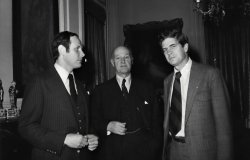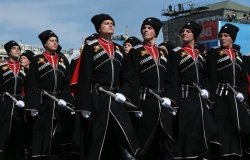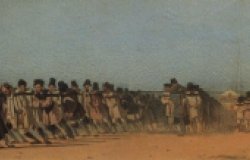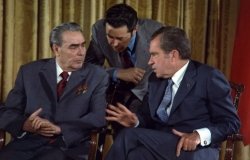Culture/Kultura: Russian Influences on American Performing Arts: Dance
The "influence of Russian ballet in America is monumental," stated Suzanne Carbonneau, Professor of Performance and Interdisciplinary Studies in the Arts, George Mason University, at the second seminar in the Culture/Kultura series, held at the Kennan Institute on 5 May 2003. "It represents the western migration of the center of the balletic tradition from late 19th century Russia to its reinvention as an American art form in the 20th century." Carbonneau, along with Camille Hardy, Principal Researcher, Popular Balanchine Project, New York, and Senior Critic, Dance Magazine, and Suzanne Farrell, Suzanne Farrell Ballet Company, The John F. Kennedy Center for the Performing Arts, provided numerous examples of the influence that Russian dancers and choreographers have had not only on the development of ballet in the United States, but also on American performing arts in the 20th century.
All three panelists agreed that the culmination of Russian influence on American dance came through the work of George Balanchine, who is judged to be one of the greatest choreographers of all time. But Balanchine was not the first Russian dancer in America. Carbonneau noted that before Balanchine, "millions of Americans, in towns all across the country, had already seen Russian dancers…and the phenomenon of Russian ballet had been firmly entrenched in the American consciousness." Dancers and choreographers such as Anna Pavlova, Mikhail Mordkin, Lydia Lopokova, and Adolph Bolm created a sensation both in the world of classical dance and on the popular stage with their performances on the concert circuit, on Vaudeville, on Broadway, and in films. By the 1920s, according to Carbonneau, ballet training became essential for any actor on the musical stage, and many of the teachers were Russians: "Before they did anything else, the Russian arrivals almost inevitably cast about for teaching opportunities."
According to Carbonneau, many Americans so closely associated ballet with Russia that in the 1910s and 1920s, non-Russian ballet dancers in the U.S. "were forced to adopt Russian names." However, she emphasized that "Russian ballet" in the U.S. adopted local cultural styles. Before Balanchine, the greatest innovator in this area was Bolm, who "envisioned the establishment of a uniquely American art dance, one that would contain reference to Russian ballet, but which would also be responsive to the speed, energy, daring and raucousness that he saw as intrinsic to the American character." Carbonneau added that other choreographers were also influenced by the jazz music and tap dancing that typically played alongside ballet on Broadway and the Vaudeville circuits.
After his arrival in the U.S. in 1933, Balanchine "opened a new threshold for American classicism" with ballets such as Serenade, according to Hardy. Although best known today for his art dances, Balanchine was also very successful in the world of popular entertainment. Hardy argued that he "used Broadway and Hollywood to expose ballet to a diverse popular audience that he won over completely."
Hardy described the numerous Broadway productions that Balanchine choreographed and showed clips from several of his films. She argued that his productions were popular because of their imaginative and passionate dancing—combining ballet, tap, and even square dancing—and because of his use of American themes and presentation of "tough street people, with whom his audience could relate directly." Balanchine's choreography had an enduring impact on Broadway and in Hollywood. According to Hardy, "By directing the dance sequences in his films, [Balanchine] joined Busby Berkeley and Fred Astaire as pioneers in developing the relationship between camera and dancer, and left a model for subsequent movie musicals." His use of ballet to portray a dream scene in the 1936 hit On Your Toes was so popular that dream ballets became almost obligatory in musicals for the next several decades.
Farrell, a longtime student of Balanchine and principal dancer in his New York City Ballet, concluded the seminar with her recollections of Balanchine. In Farrell's view, his greatest strengths—both as a choreographer and as a person—were his understanding of human emotions and his love of people. Balanchine's great humanity allowed him "to direct [his ballets] to every single person in the audience—not necessarily a knowledgeable audience, but to every human being, to tap into their feelings." Farrell described Balanchine's ballets as full of insights on life, saying, "you can't come away from seeing a Balanchine ballet and not be changed for the better." She believes that the universality and depth of feeling in his ballets have allowed them to retain their popularity to this day.
Farrell also described Balanchine as a masterful choreographer, able to integrate classical ballet into Broadway shows, and his Russian roots into his American experiences. She asserted that despite his adoption of characteristically American styles and mannerisms, Balanchine "didn't stop being Russian when he became American." Farrell also surmised that the trauma of the Russian Revolution deeply affected Balanchine's choreography, and that "he became the choreographer that he did because he was grateful to the ballet form for giving him a life outside of Russia." She emphasized that the man who was so influential in American dance "was always harkening back to his Russian heritage."
About the Author
Erin Trouth Hofmann

Kennan Institute
The Kennan Institute is the premier US center for advanced research on Eurasia and the oldest and largest regional program at the Woodrow Wilson International Center for Scholars. The Kennan Institute is committed to improving American understanding of Russia, Ukraine, Central Asia, the South Caucasus, and the surrounding region though research and exchange. Read more











